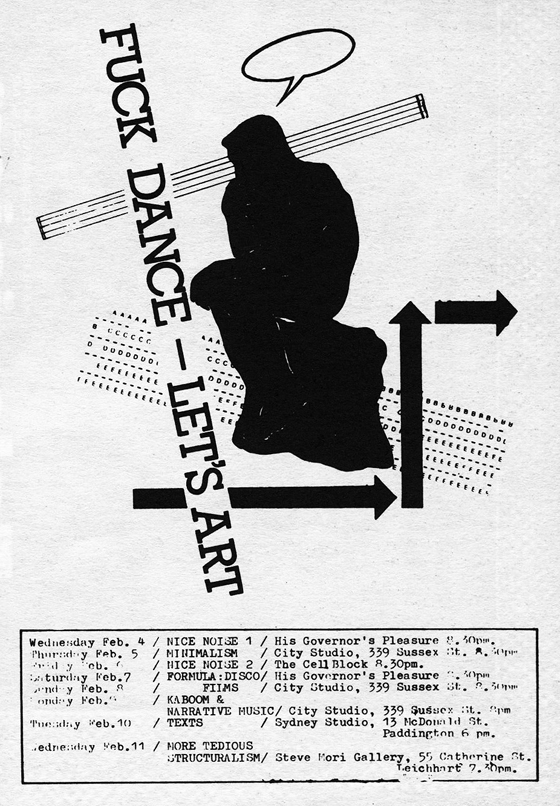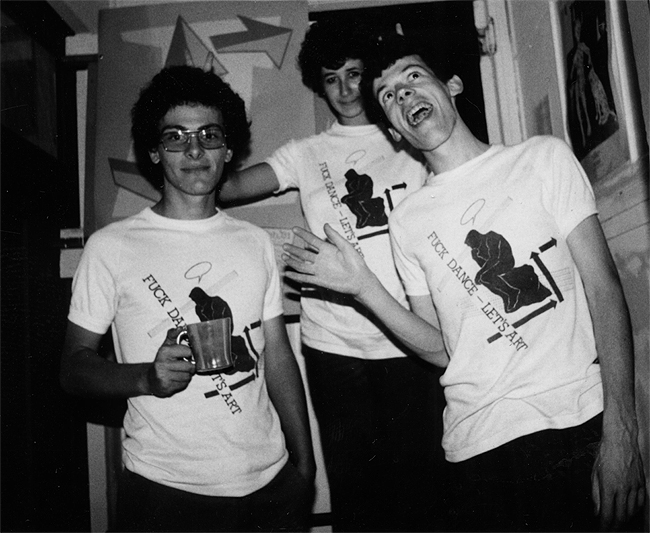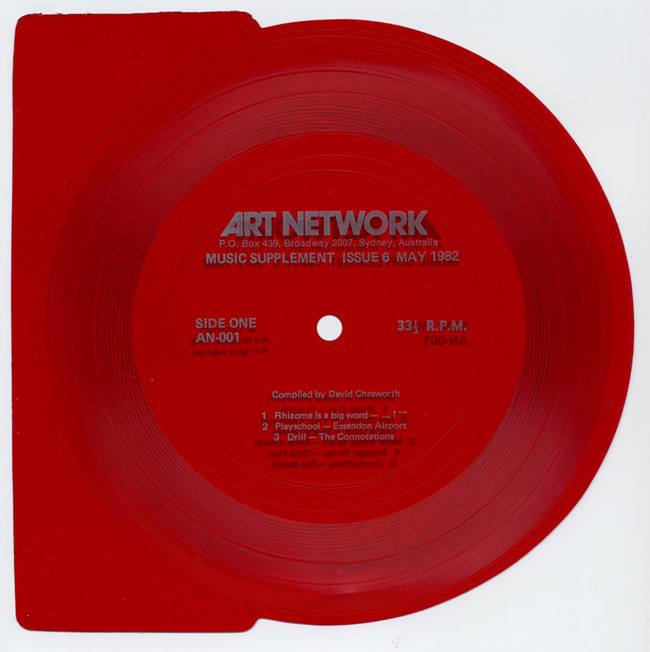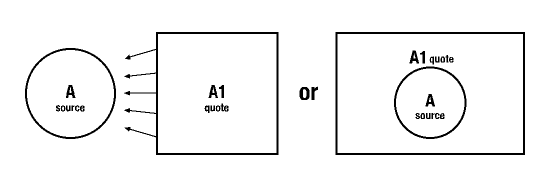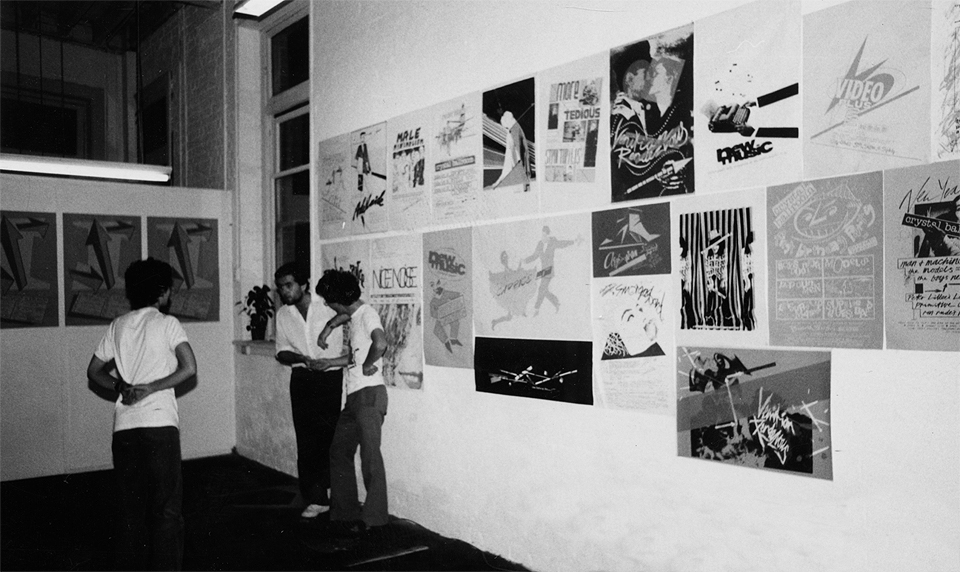Texts & Gestures
published in Art Network - No.6, Sydney © 1982written answers to questions by Adrian Martin
I've been thinking about how to define and identify the kind of music we produce in terms of certain textual elements like repetition, the degree of structure and systematisation, insistent use of quotation, and so forth. My questions are directed to each aspect. First: what does this music exclude - what is it opposed to or offered as an alternative to?
"I don't know what I want - but I know what I don't want." Let's start with the basics: creativity to do is the practice of making decisions. Decisions that are not concerned with affirmation but with a sort of interrogation. A questioning of an existing situation characterised by its convention, its conservation, its stagnation. The urge to create is (should? must be? might be? probably is? ...) prompted by a desire for change, whether it be (in historical, ideological and artistic terms) in a direction backwards, forwards or sideways. The specific direction is determined by the context, and is thus not of primary importance in itself (even though artistic criticism is most usually founded on a singular concept of direction, i.e. 'radical art moves forward').
The decision - being the basis of creation/manufacture/production - is thus part act and part gesture. It is an act of inclusion and a gesture of exclusion. As a 'direction', this means that the past is not only towards some things but also away from others. Such is the intuitive genesis of what could tentatively be a more sophisticated practice of decision-making, of creativity. And here too we have opposing notions of 'creation' - as that which remains intuitive, and that which nurtures (intellectual) sophistication. This notion of sophistication would be involved not solely with defining a particular chosen path, but with achieving a view of the map of which that path is a part; with acknowledging and critically accepting the network of paths with all its criss-crossing directions. The broader view of the map, the more different this network looks, and the less important its specific directions.
How do you justify the use of repetition as a major element in your work? Do you in fact consider it to be a major element?
No - I don't consider it a major element, because 'repetition' as a concept can be incorporated into a variety of uses. There can be a variety of types of repetition as well as a variety of ways of handling the particular type of repetition. Thus the concept of repetition becomes like a grammatical component within a musical language - too broad to be highlighted as a major area of focus.
Repetition can be used to generate a pleasure - or rather, pleasures. The pleasure in "Nice Noise Theme" (on the Nice Noise EP, 1979) is generated by the inevitability of a cyclical structure. The melody when finished has only one place to go - once more back to the start. Harmonically, the end qualifies the start qualifies the end, etc etc. However, the pleasure in songs like "Only Quantity Counts" (live), "Three Note Song" or others in the Minimalism set, is generated through hypnotic effect, of blurring the sense of exactly 'where' the listener is placed within the 'when' of the music. Time stands still - the memory is seductively fooled. "Am I hearing this before?"
Repetition can be 'realist/ic', referring to a historically constructed image of musical composition and structurally recreating that image. This is the case in the Venitian Rendezvous set, where basic forms (ABA, AABBAA, ABCABC, etc.) are used in the spirit of some sort of accurate or authentic representation of a Muzak type. Repetition can also be 'stylised', extending and analytic metaphor through artistic license, sharply accentuated in the various functions of repetition within a certain context. This occurs in the Nice Noise set where it is not simply an overuse of repetition, but the streamlining of its role within rock music. For instance, if the 'solo' in rock could be defined as a noisy 'difference' bursting forth from a blandness, a sameness, these are the only two elements required to construct the song "Doing Very Little".
And of course, the list goes on. A list that, by virtue of its length and complexity, disqualifies the dumb comment "it's too repetitious". How would I justify the use of repetition (or rather, how would I qualify my disqualification of dumb comments like the above)? I would do so by referring to the role of repetition within the music and not by defending 'repetition' in a blanket, dogmatic fashion.
What is the function of highly structured music? Would you give it an aesthetic defence or would you position its signification elsewhere?
'Highly' structured? Obviously, the reference to structure here is in the sense of there being 'too much' or 'not enough' or 'abnormal' structure. Music history is basically an endless perpetuation of some sort of mythical object defined by a harmonious (i.e. self-dissolving) balance between content, form, structure and texture. There always seems to be some sort of gravitational pull towards such a concept (or away from it, etc). It becomes the home base, the headquarters of all binary oppositions. I could call any music 'highly' structured if I deliberately and consciously focus on a particular hierarchy of compositional processes and textual components. (Wasn't there some 'analyst' who reduced Wagner's Ring Cycle down to a minor third interval?) 'Structure' is not simply a noun - although the fact that it is a noun is very important (remember from primary school: "a noun is a naming word"). It is also a verb - a compositional tool and a critical perspective. One can replace the other - the critical perspective can foreground the compositional tool and vice versa. "One Note Song" is an active construction of the conceptual structure known as the one note. But a conceptual structure of the same order can exist in something as sloppy as Van Morrison, as dramatic as Ravel, as exotic as Ravi Shankar, or as intense as the Sex Pistols.
Structure, however, is traditionally divorced from the more 'productive' (i.e. gratifying, seductive) modes of interpretation and reception. Structure is usually hidden, but it is often exposed also, and pleasure can be derived from this exposure. This is the very basis of dub music - hearing not only what is made to present but also what is made absent. Rhythm itself is a temporary structure, defined by tempo, beat and syncopation. In this sense, recognisably rhythmic songs could also be called 'highly structured'. But - getting back to the answer that your question desires - 'highly structured' music is essentially subtractive: it removes the compositional components that are designed for the more traditional modes of interpretation and reception. Thus, what is absent in the solo (technical expertise), the lyric-ism (social/humanist communication of [deep] meaning), textural complexity (compositional finesse), dynamic arrangement (performance energy), etc etc. The attraction of such music is that it is free (relatively) of these textual elements. The purpose of such music would be to question why such elements (at this point in music history) are involved in such an inclusion/exclusion dichotomy. Obviously, I'm not talking about aesthetics but of the "elsewhere" - in fact, I'm probably talking about the politics of music composition at a historical conjuncture - that is, now.
What is the role/ intended effect of highly systemised differences and dynamics in your musical arrangements?
Difference? The question is strangely worded. This 'kind' of music that is spoken of could be called music that is turned inside out so that the 'differences' appear to be more visible (heard) but only really because the structural elements have been organised in such a way as to clearly show their interrelationship. The more sharply defined the textual elements the more apparent their differences; and thus the more structured the music. On a formalist level, music not of this 'kind' tends to blur or obliterate its contained differences, harmoniously cancelling out each element with all the other elements (musical hegemony?) in pursuit of some sort of balanced, smoothed-out object - otherwise called a 'sealed text'. The role, then, of highlighting systemised differences would be to pen the musical text, to turn it inside out.
Aside from this, my approach to music arrangement (which is, incidentally, 50% of the compositional process) stems more from a practice of graphic design then from a knowledge of music theory. I have a 'natural bent' toward the design based upon bold lines, sharp edges, dynamic forms, as opposed to the messy, grey pencil sketch. Thus, I would call my music 'graphic' in every sense of that word. Its effect would be pleasurable (I hope) - but the sort of pleasure derived from knowing, being exposed to, feeling the underneath of the music. The area of this 'kind' of music's effect is still largely uncharted, but mainly because its political function is still heavier or louder being the quality, effect and feel of the actual music. This means that words like "boring" and "intellectual" are prompted more by a reactionary stance then an evaluation of this kind of musical approach.
Are you aware of having formulated what could be identified as a personal compositional style? What implications would it pose for you if it were so?
Yes and no. I spent 1975 to 1979 fighting personal style until I realised it was pretty silly to attack it from the angle of denying its existence. Style is style - but things are more interesting beyond style. If my style is analytical, then the style is only superficial and dull compared to the actual analysis. Personal style (with that emphasis) smothers the open text with the well worn blanket of artistic intention - that's great historicist shadow of the artist. What I'm still attacking, though, is the way that personal style fits into critical evaluation. As part of any sort of art practice it is, to say the least, impotent. Replace the phrase in your question "your personal style" with "a particular approach" and I would be more comfortable. In fact, the further away I am from art that is created by individual humans (as opposed to art that is culturally produced) the happier I am. To quote myself from three or so years ago: "human being: being human - what a way to be". Yes, I'm still 'cynical'.
In employing quotation as a musical strategy, what different kinds of quotation are operative for you? Do you work on distinctions between 'straight' quotation and reworked quotation? What is the intended effect of a quotation on someone who hears it? How would you define/explain the oft-mentioned quality of 'corn' in this music?
Before we start particularising a notion of quotation into a series of approaches, we should go over the basic question - what is a quotation? Perhaps we should first try to discover what isn't a quotation. We are thus landed with a conceptual paradox: on one side we can say that everything has a quotation basis in reference to (any) history; on the other hand we can say that this basis can be relatively ignored in reference to the uniqueness of each thing, the soleness of its utterance. Therefore, we should perhaps avoid using such broad distinctions for specific definitions.
The point is, what is it that the quote is highlighting, pointing to, declaring? The speaker? The source? The quote? I feel that a quote is most easily felt as something in one space pointing to another space - as well as giving the illusion that this other space is occupying the initial space. Let's try a diagram: taking A to represent the source of the quote and A1 to represent the quote, we can do picked the two possible views or perspectives of quoting as:
In a sense, there is a hazy distinction between the quote's dislocation of its source and its embodiment of that source. However what would have to be defined here is the role of the quoter, whose action and presence defines or instigates the action and presence of the quote. We'll return to this. Anyway, I think that one could start to distinguish types of quotations in terms of dislocation and embodiment. The pleasure afforded the listener could also be approached in these terms. The whole 'genre' of Mutant Disco generates a pleasure in dislocation - we like this disco music because it isn't disco music. It probably constitutes what could be called a 'negative genre' (perhaps I'm trying to rephrase the theoretically frustrating notions of the 'second degree'). As for the embodied quote, we could look at stylistic categorisation where the foundation of the quote is openly and historically accepted in the quotation, eg. we like the blues because it is the blues.
The 'now' - the point of quotation - is important because in as much as quotation is like forming an individualised cats cradle with threads of history, it is the point of quotation which determines its historical plane. Possibly in a a few years time, one will not be able to produce Mutant Disco as we know it (although it seems as though one will always be able to produce the blues).
Perhaps it is the presence or submergence of the speaker which qualifies the degree of quotation, ranging from a violent gesture to a muffled whimper. Examples would be Japan for the former (their violence is at times awkwardly beyond comprehension) and ABBA for the latter (their only 'individuality' arises out of over-exposure to what is essentially a microscopic amount of 'newness' or 'specificity' in their quotation of bland European MOR pop music - their identity is now secure due to the intrinsic relation to a particular time - they are now history). Following on from this, Japan is consequently named 'rip-off' in negative terms and 'stylistic' in positive terms. ABBA becomes, respectively, 'crass' and 'popular'.
So what of the "intended effect"? Well, the role of the quotation is not merely to quote, but to declare itself a quote, generating a recognition of and identification with the source. It is in the actual declaration of the quote that the listener is most intrinsically and fundamentally engaged. I've already mentioned pleasure in relationship to quoted works, but there must also be, I think, some sort of cultural politic involved in the employment of quotation. This is where we could return to our initial broad historical distinction between kinds of quotation. Namely, in a process of writing (and publicly engaging in writing) history.
In this light, the difference between quotation and non-quotation would be the difference between writing (rewriting) history for oneself, and having history written for oneself. The former involves a chronological dislodging of a part of history from that history's writing, whilst the latter involves a respect for the 'natural' (self-determined, unquestionable) flow of that history's writing. So now we can confuse the issue even more with related phenomena like 'revival', 'nostalgia', 'camp', 'satire', 'parody' etc. However, by juxtaposing the notion of quotation against these terms we might be getting somewhere, because these less controversial terms aren't as problematic. Their context of quotation is more clearly defined, more concretely stated. The quotes there have a communicative purpose, function and effect. In other words, their particular chronological re-ordering is accepted. The other, more difficult kinds of quotation we're trying to define get situated as precisely 'other', devoid of reason, thus criticised on the grounds of 'aimlessness'.
The more conventional modes of quotation are hemmed in by barriers, constraints - cultural, political, mythical etc. - and this 'other' quotation crosses such barriers respectively: whites playing black music; the avant-garde forging backwards, structuralist/humorous jibes at expression and creativity, etc. It is these barriers which define the context for the quotation in nostalgia, camp, satire and the rest. And it is these barriers that are also perhaps responsible for the oft-mentioned quality of corniness/cheesiness/dagginess/etc. associated (through misinterpretation?) with New Music - it's as if the crossing of the barrier is misrecognised, because there is no new context for the quotation, no new purpose, role and effect in the concrete senses associated with the other sorts of quotation. Thus, Television Works is seen as parody or satire because the context of quotation is more problematic (and therefore harder to clearly locate and express). Once again, the Xerox syndrome appears - "you've shown me nothing I couldn't already have seen myself on television".
The nearest thing I could associate the quotation in the New Music with would be Pop Art. Both modes of quotation deal with actions and gestures related to art practice, although Pop Art was more in the domain of culture (high versus low) whereas this type of New Music is more in the domain of history (old/then versus new/now). Pop Art, too, encountered the Xerox syndrome, mainly because the artists had formally, not conceptually, suppressed their originality - Warhol and Lichtenstein did not 'interpret' their subject matter, they 'handled' it, set it in motion in a new context. The notion of Xerox connotes an absence of the human, the artist, the creative decision, the mechanics of idea and craft, the message, etc. Pop artists historically abused their artistic license - as are the 'pop artists' of now.
In ending, I refer to my article on disco (the title of which abounds in quotation marks) "What is this thing called 'Disco'?". The title was very important in indicating the direction of its theory, the direction it's utilised - one of deliberately and explicitly quoting, drawing is much attention to the act of quoting as to what was being quoted. As if in answer to this article, another appeared in The Face titled What is Funk?. And it is important to notice the absence of quotation marks in this case, as the article was concerned with the existence of a fully fledged, unchangeable, 'first degree' object: Funk. The article is very critical of the fake funk that currently has Britain by its fashionable throat. In other words, the article had not recognised the quotation marks of the Brit-Funk movement (New York group The Lounge Lizards were probably the most vocal on this score, openly calling their brand of jazz 'fake jazz').
The trick, then, is to construct a cats cradle based upon a difficult balance between the quote and its source, where each mirrors (xeroxes?) the other, declaring each other's sameness and difference. Can anyone lend me a hand?
Text © Philip Brophy & Adrian Martin. Images © Philip Brophy.



